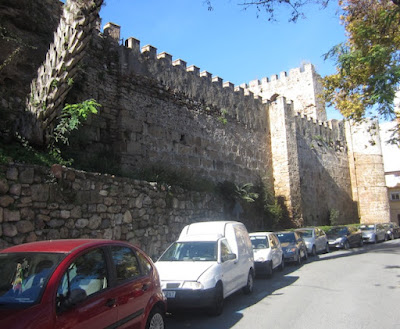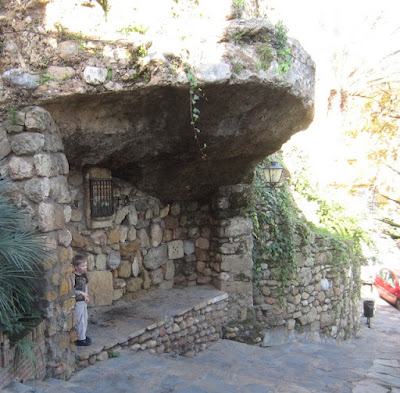After our snack in the Plaza de los Naranjos, we headed north to see the old fort (alcazaba in Spanish) and the original town walls. We also found a closed church and a bunch of interesting shops.
The stairs up to the fort were nicely decorated. Tiles really are everywhere here.
The alcazaba dates back to the 10th century and was built by the Moors out of stone, recycling some of the ancient Roman material (they had a fort here too). The fort was rectangular in shape, situated on the highest part of town. Narrow, winding streets snake out from here.
The walls date back to the 9th century and include a niche where a rocky outcropping provides a little shelter from inclement weather. It hardly ever rains here, so I imagine the niche does not get much use.
The little street chapels or shrines have been a part of the urban scene for a very long time. They are quite popular and nice reminders of the Catholic culture of Spain for everyone passing by.
We wandered a little further north to the Hermitage of the Holy Christ of the True Cross. This church is thought to be built by Franciscans, since the order has a devotion to the True Cross. It was built in the 16th century but had many additions (including the bell tower) in the 18th century. The plaza has a nice fountain and a random cat was hanging out.
A flamenco joint is right next to the church, but the shows are at night so we did not get to see any dancing in Marbella. We did walk back toward the sea and saw many interesting shops and signs.
The stairs up to the fort were nicely decorated. Tiles really are everywhere here.
 |
| L makes a close examination of the steps |
 |
| A tile deer to L's hart |
 |
| View from the top of the stairs |
The alcazaba dates back to the 10th century and was built by the Moors out of stone, recycling some of the ancient Roman material (they had a fort here too). The fort was rectangular in shape, situated on the highest part of town. Narrow, winding streets snake out from here.
 |
| Old fortification with a new home built on it |
 |
| More narrow streets |
 |
| Wall and tower |
 |
| Another tower |
The walls date back to the 9th century and include a niche where a rocky outcropping provides a little shelter from inclement weather. It hardly ever rains here, so I imagine the niche does not get much use.
 |
| Rocky overhang |
 |
| J poses by the small shrine |
 |
| L looks at the shrine |
The little street chapels or shrines have been a part of the urban scene for a very long time. They are quite popular and nice reminders of the Catholic culture of Spain for everyone passing by.
We wandered a little further north to the Hermitage of the Holy Christ of the True Cross. This church is thought to be built by Franciscans, since the order has a devotion to the True Cross. It was built in the 16th century but had many additions (including the bell tower) in the 18th century. The plaza has a nice fountain and a random cat was hanging out.
 |
| Ermita del Santa Cristo de la Vera Cruz |
 |
| Plaza fountain |
 |
| Plaza cat |
A flamenco joint is right next to the church, but the shows are at night so we did not get to see any dancing in Marbella. We did walk back toward the sea and saw many interesting shops and signs.
 |
| The pharmacy is on Estacion, it's been there for years! |
 |
| Handbags in many styles, including dragons and crowns |
 |
| We didn't think we'd see any Welsh on signs here |



No comments:
Post a Comment